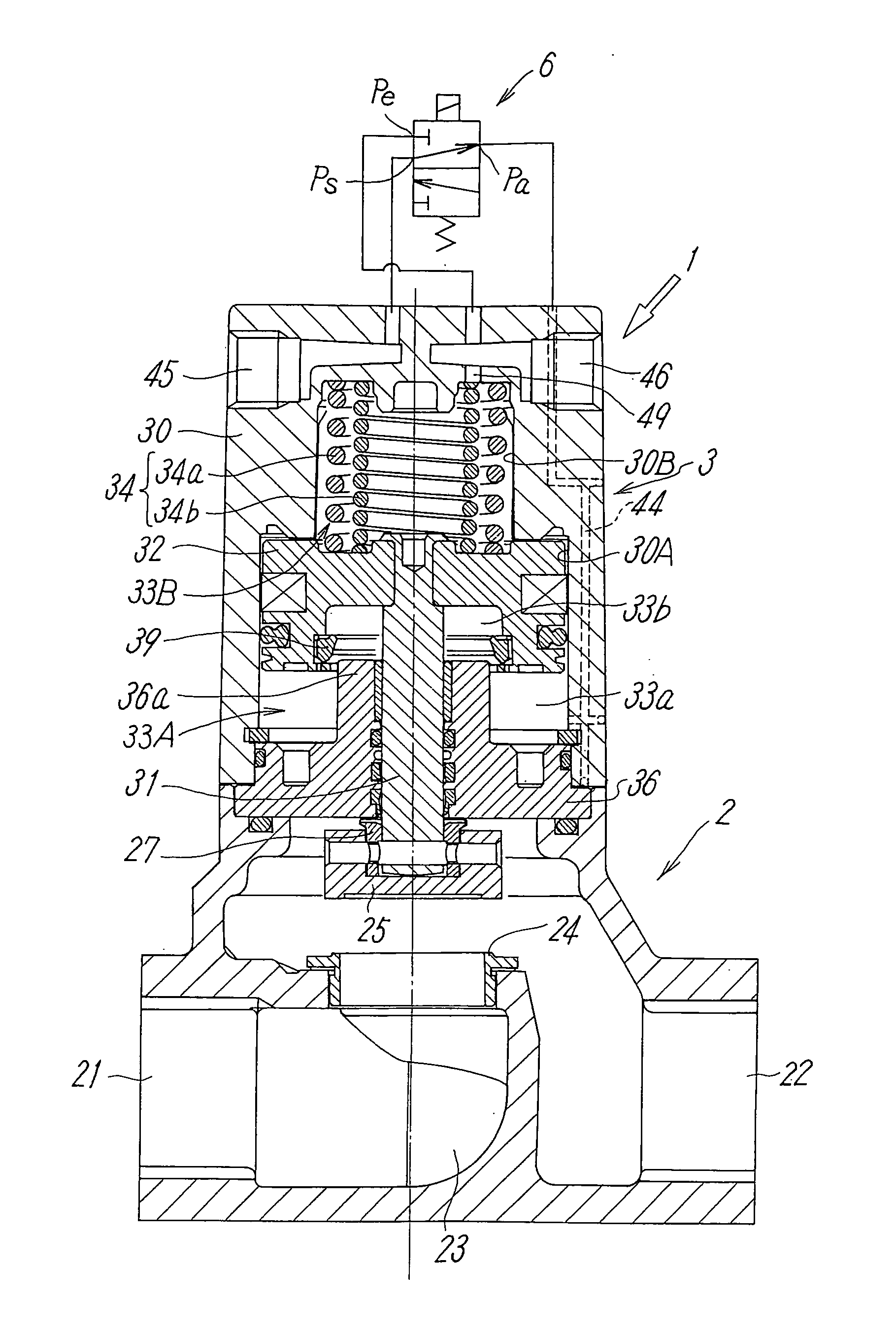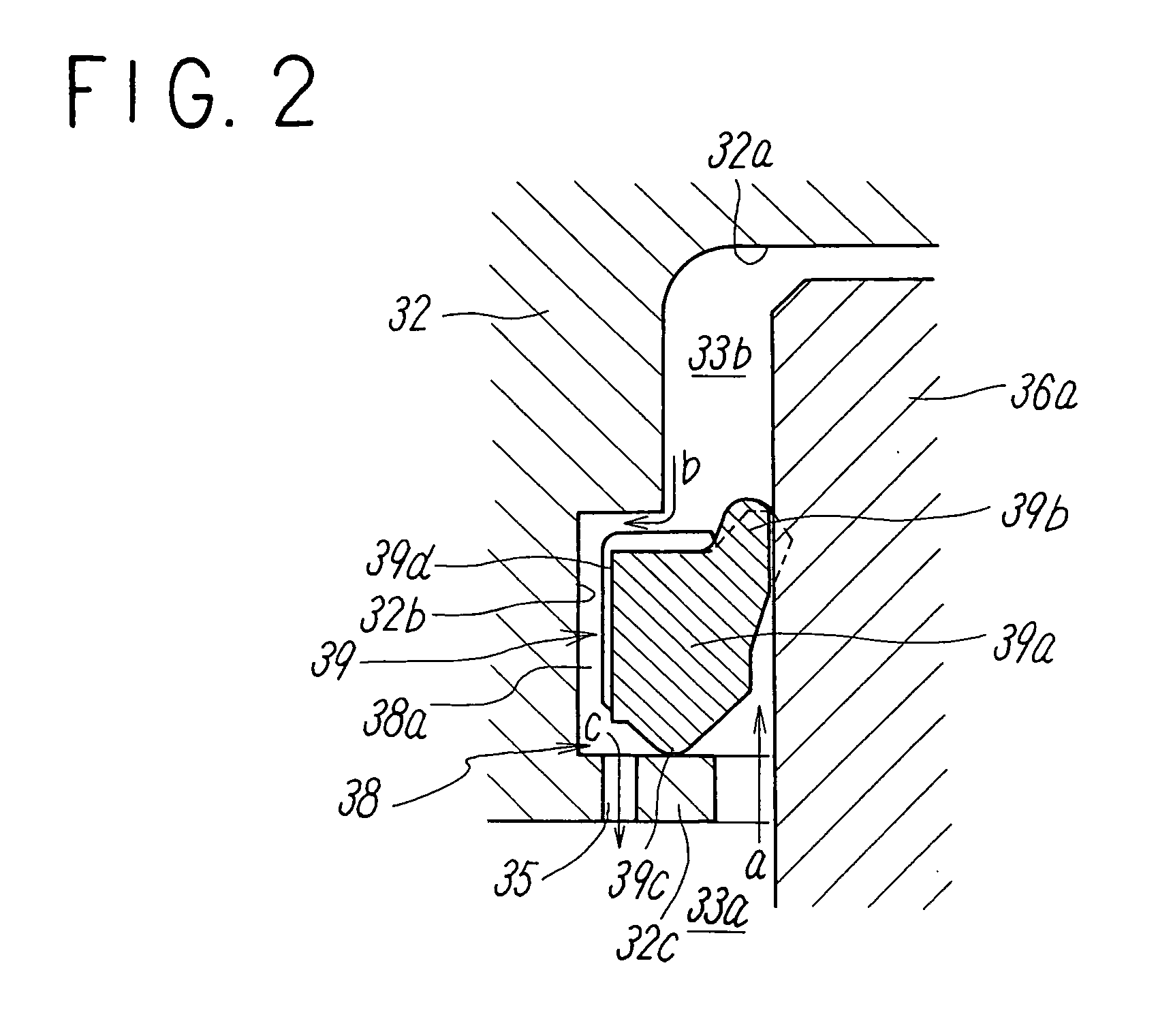Pilot-type two-port valve
a two-port valve, pilot-type technology, applied in the direction of valve details, valve arrangements, valve members for absorbing fluid energy, etc., can solve the problem of water hammer phenomenon during the closing of the valve, and achieve the effect of preventing water hammer
- Summary
- Abstract
- Description
- Claims
- Application Information
AI Technical Summary
Benefits of technology
Problems solved by technology
Method used
Image
Examples
first embodiment
[0043] Now, the operation of the first embodiment mentioned above is described below.
[0044] As shown in FIG. 1, when opening the main flow passage 23 with the valve in closed state wherein the valve member 25 is held in abutting contact with the valve seat 24, the pilot valve 6 is energized to cause the inlet port Ps to communicate with the outlet port Pa. This allows pilot fluid to flow into the piston pressure chamber 33a of the first piston drive chamber 33A via the pilot flow passage 44, after which pilot fluid acts on the lip portion 39b of the seal member 39 to push open the same and flows into the damper chamber 33b. Simultaneously, pilot fluid passes through the orifice 35 into the damper chamber 33b through the devious flow passage 38a. Then, pilot fluid under pressure reached the piston pressure chamber 33a and the damper chamber 33b drives the piston 32 against a spring force of the resilient member 34. This allows the rod 31 to move the valve member 25 away from the valv...
second embodiment
[0053] With the second embodiment, a guide flow passage 58 is comprised of an opening and closing flow passage 58a, in which a one-way seal member 59 is disposed, and a devious flow passage 58b formed in the columnar section 36a of the plate 36 so as to bypass the flow passage 58a. The devious flow passage 58b has an outlet provided with an orifice 55 for limiting the flow rate of fluid. The seal member 59, made of resilient rubber material and formed in a ring shape with a V-shape configuration in cross section, includes an outer wall 59a held in tight contact with the inner peripheral wall of the recessed portion 32b of the piston 32, a base portion 59b held in tight contact with the annular flange portion 32c of the piston 32, and a lip portion 59c obliquely extending from the base portion 59b toward a circumferential periphery of the columnar section 36a of the plate 36.
[0054] The devious flow channel 58b, provided with the orifice 55, is formed in the columnar section 36a at an...
third embodiment
[0057] Next, description is made of a pilot-type two-port valve according to the present invention with reference to FIGS. 7 to 10.
[0058] The two-port valve of the third embodiment differs from the second and third embodiments in the valve drive mechanism 3 in respect of the means for limiting a discharge speed of pilot fluid for the closing of a valve in proportion to a supply speed of pilot fluid for the opening of the valve and no difference exists in other structures. Therefore, description is made with a focus on the above different points while the same component parts bear the same reference numerals as those of the first embodiment and description of the same is herein omitted.
[0059] Further, although the pilot valve 6 and the flow channel plate 7 can be selectively utilized, description and illustration of these component parts are herein omitted.
[0060] A two-port valve 11 of the third embodiment, shown in FIG. 7, has the main valve mechanism 2 that is not substantially d...
PUM
 Login to View More
Login to View More Abstract
Description
Claims
Application Information
 Login to View More
Login to View More - R&D
- Intellectual Property
- Life Sciences
- Materials
- Tech Scout
- Unparalleled Data Quality
- Higher Quality Content
- 60% Fewer Hallucinations
Browse by: Latest US Patents, China's latest patents, Technical Efficacy Thesaurus, Application Domain, Technology Topic, Popular Technical Reports.
© 2025 PatSnap. All rights reserved.Legal|Privacy policy|Modern Slavery Act Transparency Statement|Sitemap|About US| Contact US: help@patsnap.com



